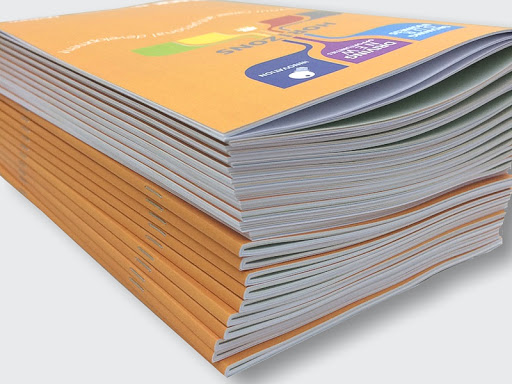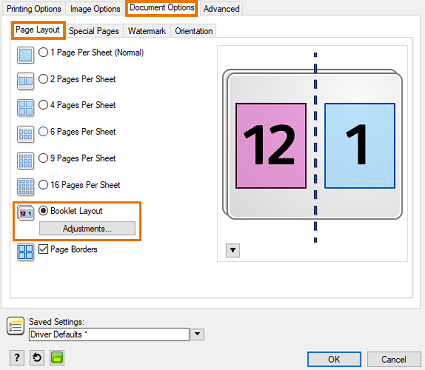How Booklet Printing Supports Omni-Channel Marketing Strategies
How Booklet Printing Supports Omni-Channel Marketing Strategies
Blog Article
The Essential Overview to Understanding Pamphlet Printing Options and Techniques
The procedure of pamphlet printing includes multiple factors to consider that can substantially influence the final item. From choosing the appropriate layout and size to recognizing the subtleties of binding techniques, each option plays an important function. Additionally, aspects such as paper stock and printing methods more influence the efficiency of the booklet. As one browses these choices, it ends up being essential to comprehend how they adjoin and what that indicates for the overall result.
Understanding Pamphlet Dimensions and styles
When taking into consideration pamphlet printing, comprehending the numerous formats and sizes readily available is important for accomplishing the desired presentation. Brochures can be produced in many styles, including saddle-stitched, spiral-bound, and perfect-bound, each offering unique benefits. Typical dimensions range from standard letter (8.5 x 11 inches) to smaller sized alternatives like A5 (5.8 x 8.3 inches), enabling adaptability based on material and target audience.Selecting the appropriate dimension can affect both the design and reader engagement. Bigger sizes may suit aesthetically driven material, while smaller sized layouts may be much more easy to use and portable. Furthermore, the variety of web pages affects the option of binding approach, as thicker brochures might require stronger bindings. Inevitably, comprehending these elements enables a much more customized approach, making certain that the end product straightens with the intended message and visual, boosting the total performance of the communication.
Choosing the Right Paper Supply

Binding Approaches: Considerations and alternatives
When it concerns binding methods for brochures, several options are available, each with distinct benefits. Saddle stitch binding uses an affordable option for thinner brochures, while excellent binding strategies provide an even more sleek try to find thicker magazines. Wire-O binding stands out for its longevity and simplicity of use, making it suitable for records that call for adaptability.
Saddle Stitch Binding
Saddle stitch binding provides a functional and cost-efficient service for constructing booklets, making it a prominent choice amongst publishers and companies. This binding method includes folding sheets of paper in fifty percent and stapling them along the fold line, producing a neat and well organized appearance. Normally appropriate for brochures with a lower web page count, saddle stitching is excellent for magazines, pamphlets, and instructional materials. The simpleness of this strategy permits quick manufacturing and is usually preferred for advertising products or brief runs. Nevertheless, it is important to note that saddle stitch binding might not be ideal for thicker brochures, as the spine might not hold up under increased weight. On the whole, it stays a dependable alternative for numerous printing tasks.
Perfect Binding Methods
Perfect binding is a widely utilized technique that supplies a professional and refined coating to publications and booklets. This technique entails gluing the pages with each other at the spinal column using a strong adhesive, enabling for a clean side and the ability to hold a larger number of web pages contrasted to saddle stitching. Perfect binding is specifically suitable for thicker booklets, such as directories and yearly records, where a durable, level spine is preferred. In addition, it offers the choice for a published cover that can be made to enhance visual charm. However, considerations such as web page matter, paper weight, and the intended use of the brochure must be taken into account, as they can affect toughness and total quality.
Wire-O Binding Options
Wire-O binding, known for its resilience and versatility, uses a superb alternative for pamphlets that call for very easy web page transforming and a specialist look. This binding approach uses a collection of steel loopholes that hold pages safely, enabling them to lie flat when open. It is particularly suitable for handbooks, directories, and discussions as a result of its durable nature. Wire-O binding is offered in different colors and sizes, suiting various page matters and densities. Furthermore, it permits the incorporation of tabs and covers, improving the booklet's total aesthetic. Considerations for Wire-O binding consist of the option of wire shade, the dimension of the loops, and the level of personalization desired, every one of which can exceptionally influence the last product's look and performance.
Digital vs. Offset Printing: Which Is Best for You?
When selecting a printing approach for brochures, understanding the distinctions between electronic and balance out printing is essential. Digital printing utilizes modern-day innovation to produce top notch prints rapidly and cost effectively, making it ideal for brief runs or jobs requiring fast turnaround times. It enables customization, giving the capability to publish on-demand with minimal waste.In comparison, offset printing is a conventional method that stands out in producing big amounts with regular quality. It includes transferring ink from a plate to a rubber covering, then to the paper, which leads to exact details and vibrant colors. Offset printing typically requires longer arrangement times and is a lot more affordable for larger volumes.Ultimately, the selection between digital and offset printing depends on job demands, spending plan, and wanted amount. For little, time-sensitive jobs, electronic could be the very best choice, while offset may be more suitable for bigger, high-grade manufacturings.
Designing Your Booklet: Tips and Ideal Practices
When making a brochure, cautious attention to format, typeface choice, and color usage can substantially improve its efficiency. A well-structured layout overviews the visitor's eye, while appropriate typefaces assure readability and communicate the desired tone. Additionally, reliable use color can evoke feelings and highlight essential info, making the overall layout extra impactful.
Picking the Right Format
Exactly how can one efficiently choose the ideal layout for a booklet? It is crucial to assess the booklet's objective and target audience. A clean, arranged layout enhances readability and engagement. Utilizing a grid system can help in lining up components regularly, creating a professional look. In addition, incorporating aesthetic pecking order via varying dimensions and placements of images and message can guide the visitor's eye and highlight crucial info. It is likewise important to leave sufficient white room, which prevents congestion and enables much better focus. Examining various formats via mock-ups can give insight right into exactly how the style performs in real-world scenarios, making sure that the final item fulfills both useful and aesthetic requirements. Practical Picking Ideal Typefaces
A well-chosen font can greatly boost the overall design of a pamphlet, matching the layout and enhancing the material's message. The selection of typefaces should consider readability, specifically for body text, as it assures the details is accessible to all visitors. Sans-serif fonts are typically chosen for electronic formats, while serif fonts can lend a typical feeling in published products. It's advisable to restrict font options to 2 or three to keep aesthetic coherence. In addition, font size plays a vital duty; headings need to be distinctive yet not frustrating, while body message need to be comfy for reading. When selecting typefaces, alignment with the brochure's theme and target audience is necessary for efficient communication and aesthetic allure.
Reliable Usage of Color
Shade works as an effective tool in booklet layout, leading and shaping understandings viewers feelings. It can evoke sensations of trust fund, peace, or excitement, depending upon the hues selected. Designers need to think about shade concept concepts, guaranteeing that the picked palette lines up with the pamphlet's message and target audience. For example, making use of warm shades like red and orange can produce necessity, while cooler tones like blue and eco-friendly foster tranquility.Additionally, comparison plays a vital function; complementary shades can improve readability and aesthetic charm. Uniformity in shade usage across pages better reinforces brand identification and communication. Eventually, efficient color execution not only catches attention yet likewise reinforces the brochure's objective, making it a crucial aspect of successful layout.
Completing Touches: Coatings and Special Impacts
While several think about the content and design of a brochure one of the most essential aspects, the completing touches, such as coverings and unique results, play an important function in improving its general appeal. Coatings can give security and longevity, making sure that the brochure holds up against deterioration. Matte surfaces supply an advanced, non-reflective surface, while shiny layers can make colors appear more eye-catching and lively. Unique results, like embossing or aluminum foil marking, include a tactile measurement that can create a memorable impact. These methods can highlight specific locations, accentuating essential details or developing visual interest. In addition, UV coating can give a high-shine finish that elevates the total look.Together, these completing touches not just improve the booklet's visual however additionally communicate expertise and interest to information, inevitably leaving a long-term effect on the viewers.
Cost Factors To Consider for Pamphlet Printing
Understanding the numerous price factors to consider for booklet printing is vital for organizations and companies intending to optimize their spending plans. Key elements influencing expenses consist of the selection of paper, ink, and binding methods. Greater quality products, such as premium paper or specialized inks, commonly increase the total expense. Additionally, the dimension and web page matter of the booklet play a significant duty; bigger pamphlets need more resources and time to produce.Another vital consideration is the printing technique, whether electronic or balanced out, as each has its own prices framework and viability for various amounts. Organizations should likewise consider design prices, which can differ based on complexity and the usage of specialist solutions. Eventually, delivery and handling costs can include in visit their website the overall, specifically for huge orders. By reviewing these aspects, companies can make informed decisions that straighten with their financial abilities while achieving the desired top quality in their published materials.
Regularly Asked Inquiries
What Are the Ecological Impacts of Brochure Printing?
The ecological impacts of pamphlet printing include logging from her explanation paper manufacturing, carbon emissions from transportation, and waste generation from discarded products - Booklet Printing. Sustainable methods, such as making use of recycled paper and green inks, can alleviate these impacts
Exactly How Can I Guarantee Shade Precision in My Brochure?
To assure color accuracy in a booklet, one need to make use of adjusted monitors, use expert shade profiles, perform test prints, and pick high-quality printing services that supply color matching and proofing choices for best outcomes.
What Is the Regular Turnaround Time for Brochure Printing?
The regular turnaround time for pamphlet printing varies relying on the complexity and quantity - Booklet Printing. Typically, it varies from a few days to two weeks, influenced by variables such as publishing approaches and finishing requirements
Exist Minimum Order Quantities for Brochure Printing?

Can I Print Brochures in Multiple Languages?
Publishing brochures in numerous languages is feasible. Many printing solutions provide choices for bilingual or multilingual layouts, permitting efficient communication. Cautious planning guarantees that develop elements accommodate various languages without compromising readability or aesthetic appeals. Additionally, variables such as paper supply and printing strategies more influence the effectiveness of the brochure. When thinking about brochure printing, comprehending the different formats and dimensions readily available is essential for achieving the desired presentation. When choosing a printing approach for booklets, comprehending the distinctions in between electronic and balance out printing is vital. In addition, the dimension and web page count of the booklet play a considerable role; bigger pamphlets need even more sources and time to produce.Another important consideration is the printing strategy, whether electronic or balanced out, as each has its very own rates framework and viability for various amounts. The find this ecological influences of brochure printing include deforestation from paper production, carbon emissions from transportation, and waste generation from discarded materials.
Report this page